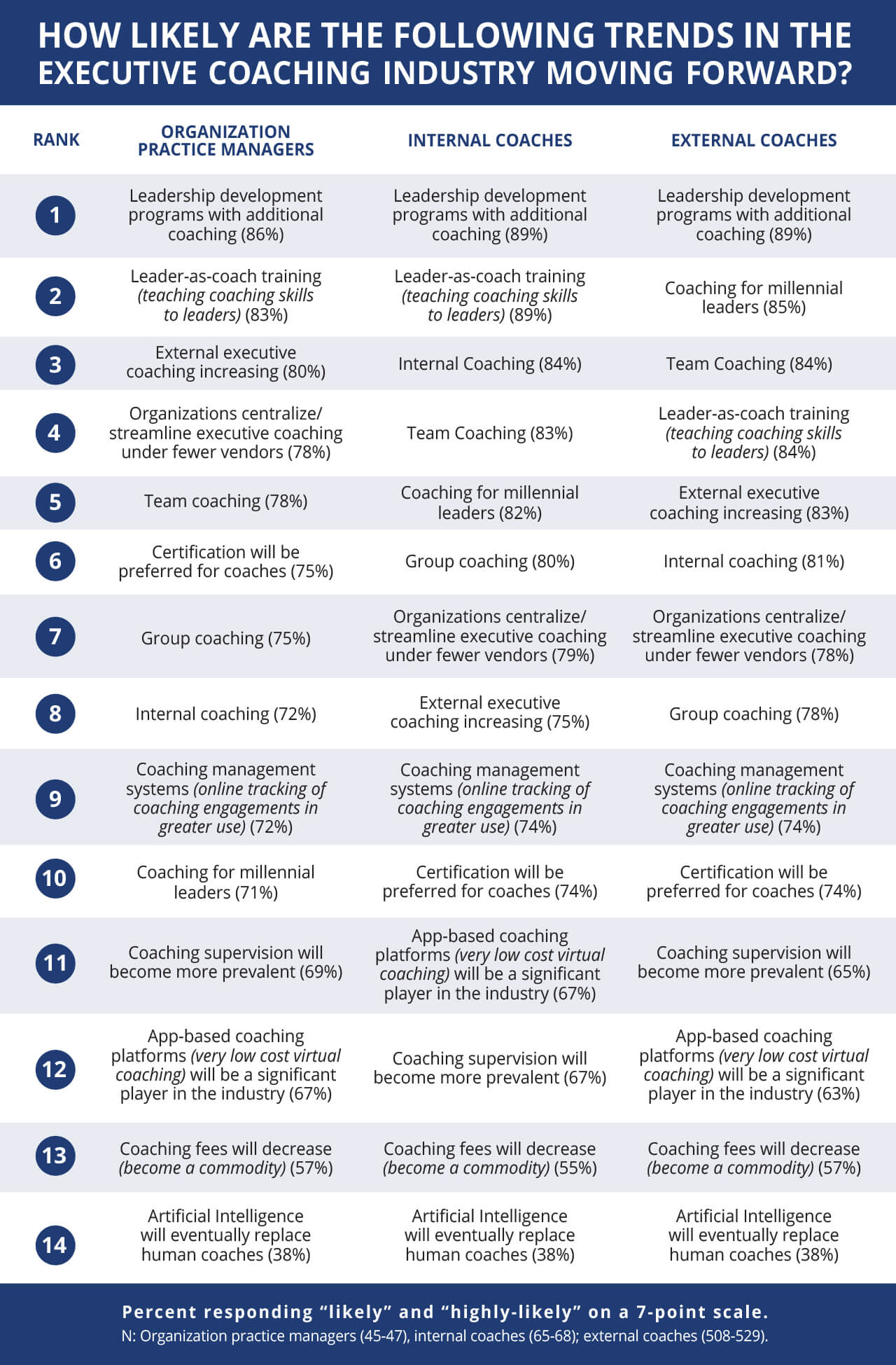Business Coaching Industry to top $15 billion in 2019
In this article:
- Global Coaching Industry Statistics for 2019
- 3 fast-growing niches for business coaches
- Executive coaching vs Business coaching
- Executive coaching 2022: future trends
- Coaching and Technology
- 2 Threats and 2 Opportunities
- 6 methods of measuring the benefits of coaching in 2019
IBISWorld estimates the business coaching industry revenue increased to $15 billion in 2019 at an annualized rate of 5.6%. In 2015, the estimated global revenue from coaching was $2.356 billion.
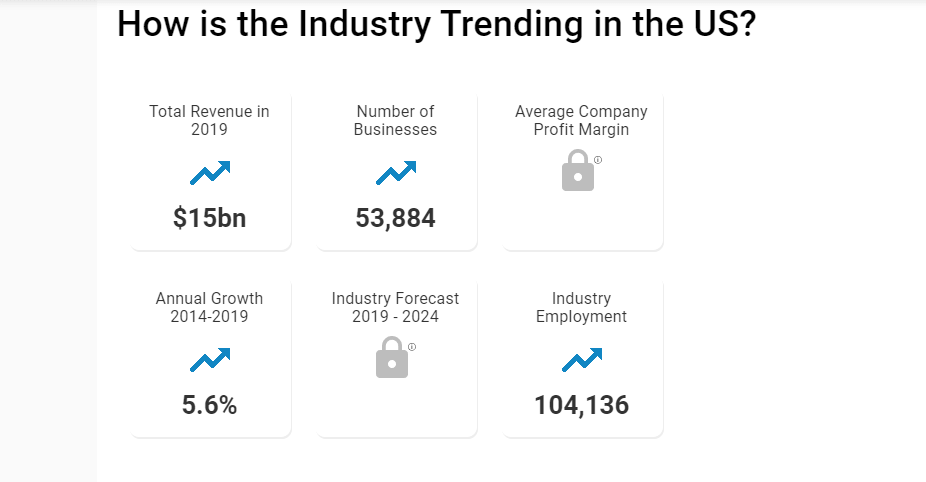
Source: ibisworld.com
Global Coaching Industry Statistics
Here are the main findings of the 2016 Global Coaching Study commissioned by the International Coaching Federation:
- Total number of coaches worldwide: approximately 53,300 professional coach practitioners;
- Total revenue generated worldwide from coaching in 2015 was $2.356 billion, representing a 19% increase over the 2011 estimate published in the 2012 ICF Global Coaching Study;
- The annual average revenue generated by coaching is $51,000;
- An active coach practitioner maintains an average of 11 clients at any given time;
- 67% of global coach practitioners are women, with the highest concentrations in North America, Eastern Europe and Oceania;
- 6% of coach practitioners are under the age of 35, with the largest numbers being in Eastern Europe (17%), Latin America and the Caribbean (11%) and Asia (9%);
- 54% of global clients are women.
1. Women empowerment coach
A women’s empowerment coach facilitates women to disengage from limiting beliefs and conditioned responses.
Women are looking to open up life choices that were previously inaccessible to them. Motherhood is no longer their sole legacy in life. They seek self-actualization and finding their unique purpose in life.
2. Employee satisfaction coach
Employee happiness and satisfaction is essential for business success and employers are aware of that. Employees want more than a higher paycheck.
The job of an employee satisfaction coach is to heal broken relationships within the workforce. Mostly it is about the employee’s relationship with themselves and their motivations within the team.
3. Sales coach
Sales coaches establish a longer and more frequent relationship with sales representatives than traditional sales training.
Their purpose is to ensure sales reps perform at their peak and bring in accounts to hit their quotas.
Executive coaching v Business coaching
In its 2019 Executive Coaching Survey, Sherpa Coaching defines executive coaching as “regular meetings between a leader and a trained facilitator, designed to produce positive changes in business behaviour in a limited time frame.”
Don’t confuse executive coaching with business coaching!
Business coaching is different from executive coaching in that it entails working to develop the client’s knowledge and skills.
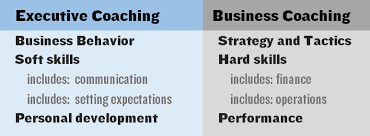
Source: sherpacoaching.com
Hourly earnings: Global figures for 2019 via Sherpa Coaching
Executive Coaches: $398 per hour, up from $386 last year and $352 in 2017.
Business Coaches: $251 per hour, down from last year’s average of $279.
Life Coaches: $208 per hour, an increase over last year at $190 per hour.
Source: coachfederation.org
Executive Coaching 2022: Future Trends
- Coaching will become a commodity and fees will decrease (57%);
- Professional coaching for Millennials leaders will increase (82%). In total, 23% of coach practitioners surveyed reported their clients are under the age of 35.4;
- App-based coaching platforms will become a significant player in the industry (67%);
- Leader-as-coach training will become more prevalent (89%);
- Team coaching will increase (83%);
- Leadership development programs will include additional coaching (89%);
- More than half of coach practitioners (51%) believe to a large extent that coaching is able to influence social change.
Learn more: How coaching your team makes you a better leader
Coaching and Technology
Technology is always changing and the way coaches deliver services will change to reflect it.
In 2012, 45% of coaches delivered their services in in-person meetings.
In 2019, this percentage decreased to 32% while web video, Skype etc increased from 15% to 25%.
Today coaches use the telephone as a delivery method the same as in 2012: 25%.
Threats and Opportunities
There are two identified obstacles for coaching:
- Untrained individuals calling themselves coaches;
- The marketplace confusion about the benefits of coaching.
The main opportunities for coaching as identified by coach practitioners are:
- Increased awareness of the benefits of coaching;
- The emergence of credible data on the ROI/ROE from coaching.
Measuring the benefits of coaching in 2019
Measuring the benefits of coaching as accurate as possible is driving the growth of the industry.
Here are 6 methods coaches are using to show the value of coaching:
- 360 Assessments (which is a before-and-after method pioneered by Marshall Goldsmith) (29%);
- Well-being and Engagement (20%);
- Performance Reviews (18%);
- Impact on Business (15%);
- Return on Investment (10%);
- Effectiveness of Learning (8%).
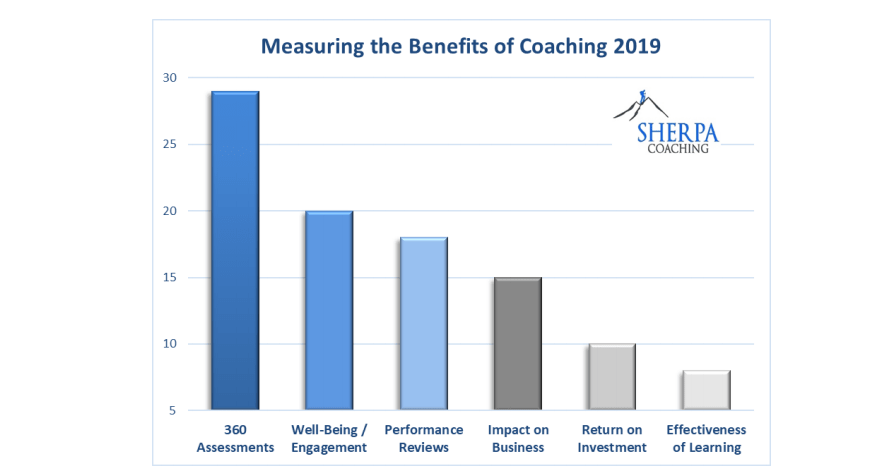
Are you going to include coaching in your leadership development programs?
Join the Conversation
We’d love to hear what you have to say.
Get in touch with us on Facebook Group and Twitter.
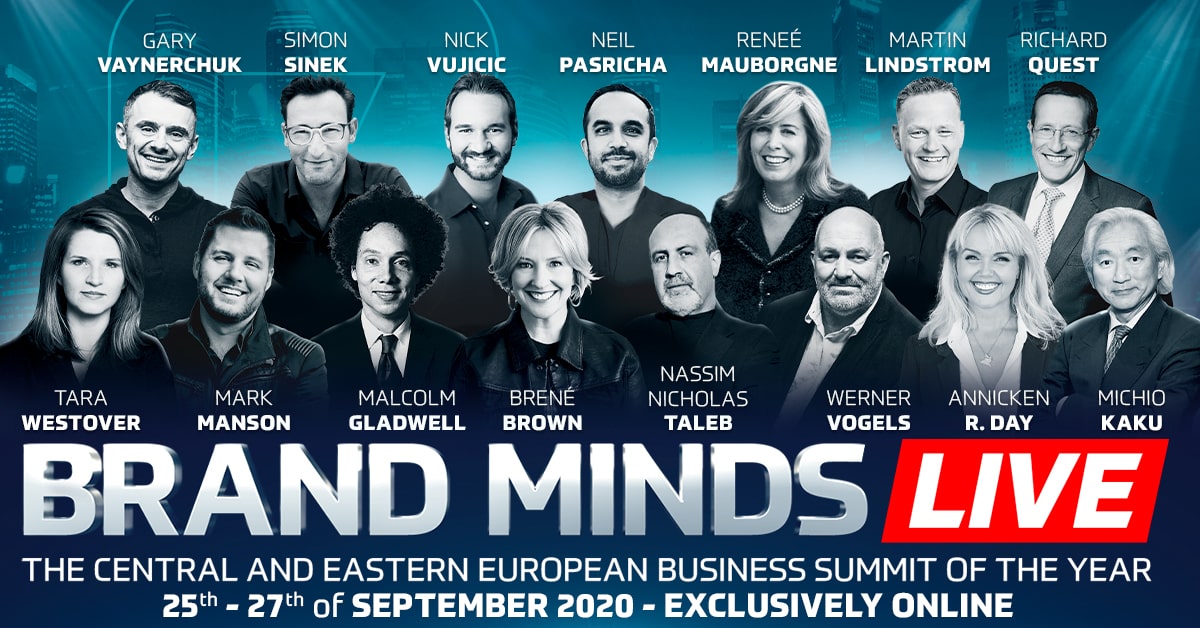
TUTOROO – Connect with in-person language tutors
Are you looking to learn a foreign language?
Read on to discover TUTOROO, the platform that connects students with in-person language tutors.
TUTOROO is an online marketplace that helps students connect with qualified in-person language tutors near them.
The platform is currently active in 19 cities across 3 continents with thousands of active users meeting up daily.
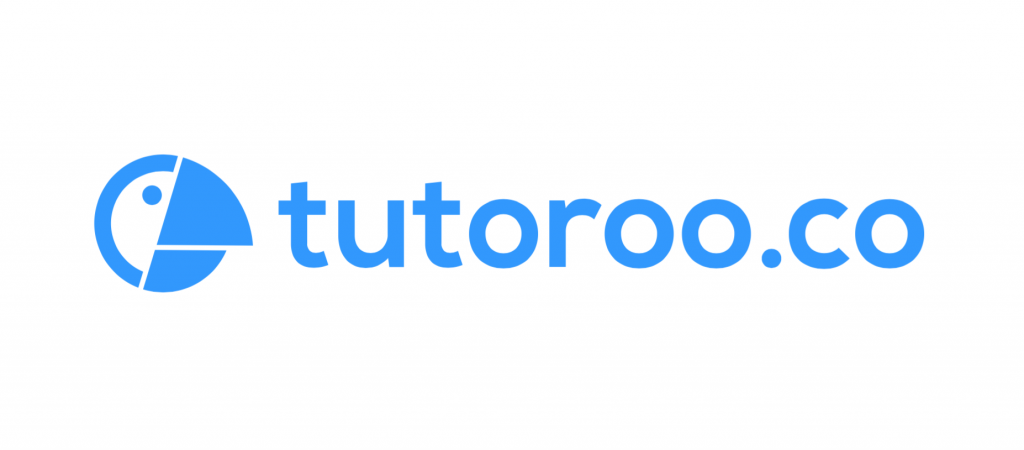
TUTOROO in numbers:
- +10,000 people matched with private language tutors;
- 19 cities across the world;
- over 1 million dollars (SGD) in cumulative revenue as of August 2018;
- +117,000 private native private tutors registered on the platform worldwide;
- 2,000 students inquiries received every month;
- The platform is currently estimated to be worth 5 million dollars (SGD).
How TUTOROO works:
- Search for a qualified language tutor nearby;
- Once you have selected the tutor you want to inquire about, the platform will contact you back on Messenger and introduce you to your preferred tutor;
- Meet with your tutor/student that match your schedule;
- Start learning together.

Benefits of TUTOROO
No one likes to learn a foreign language in front of a computer screen. In-person teaching is the best way to acquire a new language and that’s what TUTOROO offers.
TUTOROO’s tutors are people teaching their native language to students. The platform doesn’t require its teachers to have actual teaching credentials or experience. The only thing they have to be is a native speaker of the language they are supposed to teach.
Because the tutors are teaching their native language, the students learn more than grammar and a set of words. They learn a language on a conversational basis as well as the culture of their tutor’s home country. The tutors are encouraged to share knowledge, not only language.
TUTOROO doesn’t require tutors to deliver their classes in a classroom. The tutors are free to set their own schedule together with their students to their convenience. There is no fixed curriculum, it all revolves around meeting the student’s needs.
Tutors are allowed to teach according to their own methods as long as it is agreeable with the student.
There are no registration fees or agency costs for tutors. The platform gets the earnings from the tutor’s first 2 weeks of classes. After that, the student pays the tutor directly.
Join the Conversation
We’d love to hear what you have to say.
Get in touch with us on Facebook Group and Twitter.
How Brand Partnerships Move Your Business Forward (with examples)
As a business owner, you are competing with other businesses in your market for the attention of your customer base. What if you took a different approach: choose to build brand partnerships instead of competing with each other?
Step down the competition race and learn how brand partnerships move your business forward.
In this article:
- Three examples of brand partnership: Virgin Atlantic x Aviation Gin, YouTube x Waze, Coca Cola x Disney
- 5 factors for a successful brand partnership
- 9 benefits of brand partnerships
Brand Partnerships: Virgin Atlantic x Aviation Gin, YouTube x Waze, Coca Cola x Disney
Virgin Atlantic x Aviation Gin
In September of 2018, Virgin Atlantic announced a partnership with Aviation American Gin owned by actor and producer, Ryan Reynolds.
The famous UK airline founded by Sir Richard Bronson would serve the award-winning gin to their Upper Class passengers and Club Gold members.
Here’s what Sir Richard Branson said on this partnership:
Working with Ryan and his team on this partnership has been so exciting. Aviation Gin is a true icon born out of a spirit of innovation, so serving it on board Virgin Atlantic flights seemed like a natural combination.
YouTube x Waze
In August this year, YouTube announced its partnership with Waze.
YouTube Premium and Music Premium subscribers can safely listen to their favourite music from directly within the Waze app, where they get their directions. It’s a natural match: listening to your favourite music makes driving more enjoyable.
With YouTube Music and Waze together in one experience, there has never been a more entertaining way to get around.
YouTube
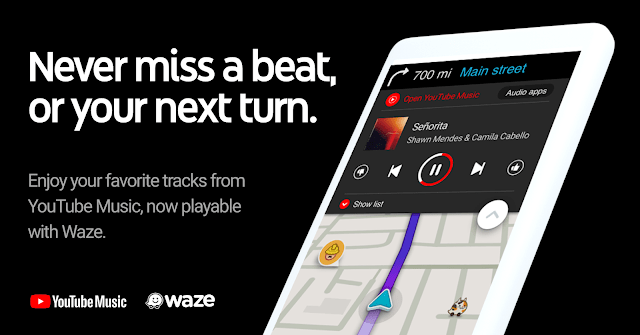
Coca Cola x Disney
Earlier this year, Disney approached Coca Cola with a novel idea for a partnership: creating custom bottles of Coca Cola for Star Wars: Galaxy’s Edge, a new experience playing at the Disneyland Park.
The Star Wars-inspired Coca Cola bottles have a rounded look and brand name printed on rusted labels in Aurebesh, the written language featured in the film franchise.

Custom bottle of Coca Cola for Disney’s Star Wars: Galaxy’s Edge / coca-colacompany.com
When we first approached Coca-Cola and shared the idea of bringing their products into the Star Wars galaxy in a new and unique way, they immediately saw the opportunity to give our guests the refreshing drinks they love in a way that maintained the authenticity of the story – which is very important to us – and that was, frankly, just plain cool.
Scott Trowbridge, portfolio creative executive and studio leader, Walt Disney Imagineering
5 factors for a successful brand partnership
Two heads are better than one, goes the popular saying. But one needs to be careful which heads – a.k.a brands – are a perfect match for each other.
Here are 5 factors you should take into account for a successful brand partnership:
- The two brands are complementary, but not competitive;
- They have similar values and target audiences;
- A shared objective and goal;
- Involve the right people from both companies;
- Bring on board senior executives and even the CEOs from both companies.
9 benefits of brand partnerships
Brand partnerships are successful when both companies start with a win-win mindset.
Here are 9 benefits of brand partnerships:
- Sharing customer bases;
- Break into new markets;
- Cross-selling;
- Expanding your customer base;
- Lead-generating opportunities;
- Brand strengths are amplified through collaboration;
- A great experience for the customers;
- Enhanced brand awareness and exposure.
Do you plan to build partnerships with other companies?
Join the Conversation
We’d love to hear what you have to say.
Get in touch with us on Facebook Group and Twitter.
Tom Adeyoola (founder of Metail®) – On building a company ahead of its time
Tom Adeyoola is a technology entrepreneur with 20 years experience in new media, disruptive technology and business models.

Tom Adeyoola / linkedin.com
Tom is the founder of Metail®, virtual fitting room service for fashion retailers.
Metail® is a disruptive fashion/tech company whose mission statement is “Making clothing fit for all”. The company was awarded The Hottest FashTech Startup at the 2019 Europas Awards. This summer Metail® was acquired by their largest investor, the Hong Kong clothing manufacturer TAL.
In 2018, Tom was named amongst “Ones to Watch” in Top 50 Most Ambitious Business Leaders, supported by The Telegraph.
I reached out to Tom and invited him to share with us the most important moments in his entrepreneurial journey.
[bctt tweet=”Tom Adeyoola: This was the lightbulb moment. If I could harness bleeding-edge computer vision, I could find not only the route but the IP edge to deliver a world-beating startup to help make clothing fit for all.” username=”brand_minds”]
1. You founded Metail® eleven years ago. What were your thoughts setting out to build a successful company?
I had been the Head of Gaming Product Development for Inspired Gaming Group where I had taken a product from concept through to 70% market penetration in the UK in 18 months and then scaled it internationally, so was ready to move on to building my own business.
I had also worked for 5 startups after leaving University (Sportal, 3, MarquisJet, Bussetti (managed this band), Inspired Gaming Group), so had seen a lot of success and failure and hopefully had learnt enough to plot a course to success.
Having resolved myself to start my own business it became a question of what and coming to the answer took a year. I had started a monthly ‘Monday night club’ to brainstorm ideas with like-minded friends, but it was not easy to come up with ideas which I felt were big enough, disruptive enough or where I felt I could generate the necessary edge to succeed over American equivalents who could likely raise more money.
As an economist, I also loved big systems and how they worked. Being able to solve major challenges and disrupt is what drove me and in the end, I was quite surprised by where the inspiration to start Metail® came from. It came through a combination of two things.
Firstly from watching my wife’s struggles to find clothes that would suit and fit one day whilst out on a shopping trip and realising that things were no better online. On a holiday to Vietnam a month later we both had some clothes tailor-made in Vietnam and I wondered why we had to travel halfway across the world to get this service experience at a reasonable price.
Whilst this question swirled around in my mind, it wasn’t until I met Professor Roberto Cipolla at Cambridge University that I saw the technology route to then solving the online clothing fit problem.
I had reached out to Professor Roberto, a global expert in computer vision, whilst trying to create the world’s first virtual blackjack/baccarat casino game using cameras to recognise cards as they were being dealt in a casino to enable remote players to play in real-time. He had invited me in to meet him and showed me all his research work, which included going from photos of Antony Gormley to 3D accurate representations.
This was the lightbulb moment. If I could harness bleeding-edge computer vision, I could find not only the route but the IP edge to deliver a world-beating startup to help make clothing fit for all.
R&D and IP were where I was going to focus our efforts to deliver our differentiation. Hence we ended up building our tech team in Cambridge, which included 11 PhDs, generated over 20 granted patents and built a successful collaborative relationship with Professor Roberto.

Source: standard.co.uk
2. Metail® is a virtual fitting room based on machine learning and 3D visualisation technology.
What challenges did your team encounter while developing the platform?
The core challenge was that we had to build everything from scratch and a lot more of the infrastructure from the ground up than I anticipated.
Academic research shows you that things are possible, but then building something that works and is production-ready takes 3 times longer again and requires a particular skillset of people to execute.
In the early days, we even had to build our own virtual server platform because there was no commercially available cloud service that would allow you to specify the GPU component.
Running our services on the CPU would take 30 times longer and also, therefore, be 30 times more expensive. Eventually, with the explosion of the market after 6 years we were able to transition to an AWS that allowed us to scale more easily globally on cloud GPUs.
However, after building an exceptional technical and R&D team, the development challenges paled into significance when it came to commercial challenges.
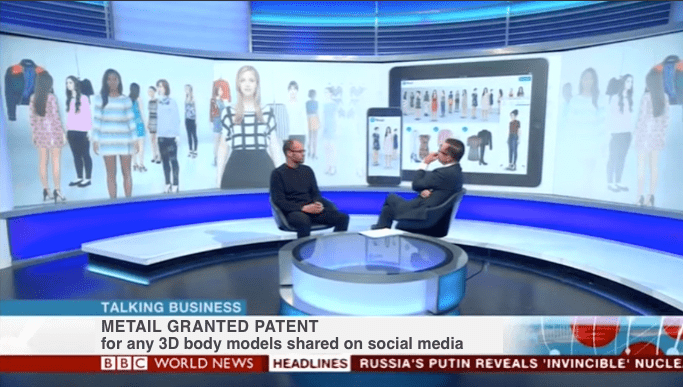
Source: Tom Adeyoola on LinkedIn
Even after 11 years Metail® was still ahead of its time, in particular, because the challenging market for clothing retailers has meant that they have been in a perpetual cost-cutting mode rather than an investment one due to the declining market: in the UK apparel sales have been declining at a rate of 2% per year as spend has shifted into other leisure activities.
Consequently, we had found ourselves in the situation of having a longer time horizon than potential clients and having to cherry-pick on the basis of whether we believed the company and team would be around in 12 months. More often than not, they weren’t.
[bctt tweet=”Tom Adeyoola (founder of Metail): There is no bigger challenge than saving the planet.” username=”brand_minds”]

Source: thetimes.co.uk
3. Share with us your vision of the future.
From a personal perspective, I intend to take on a few Non-Exec roles (already taken on one for a zero-carbon monitoring consultancy) and get involved in positive societal and climate change projects between now and the new year at which point I aim to go full bore on a new venture.
The new venture is likely to also be in apparel and will attack many of the fundamental supply chain challenges required to deliver a climate positive sustainable apparel industry.
However, it is also likely that I will work on a portfolio of ventures all with a focus on ensuring there is a hospitable planet for my kids and our future generations to live on.
There is no bigger challenge than saving the planet.
Are you a learner? Check out this app!
Are you a learner? Then check out Deepstash, the app which helps you acquire knowledge faster and retain it better.
We deliver expertly curated & reliable bite-sized ideas from any online article. You absorb, remember and act more, with just 5 minutes per day.
Deepstash
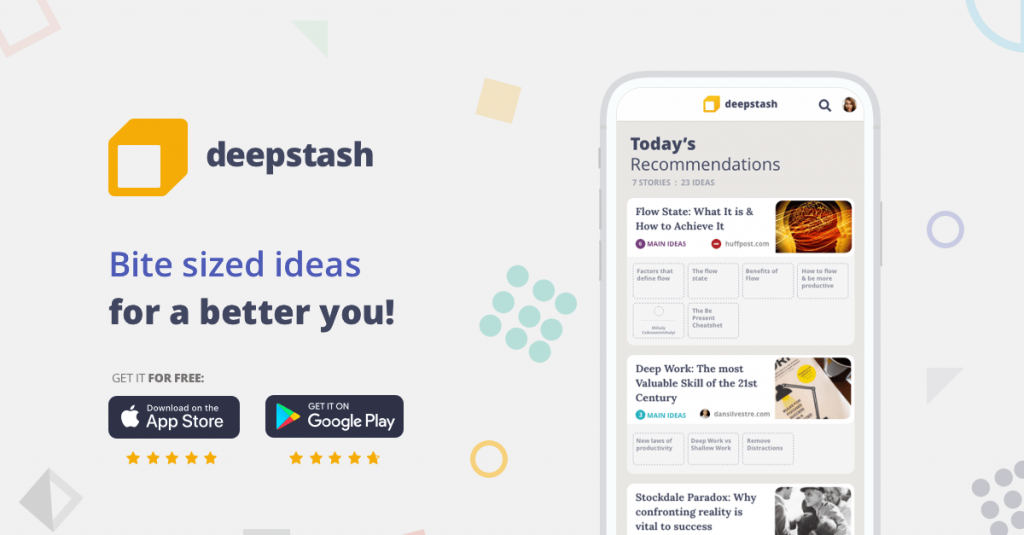
Source: deepstash.com
Deepstash is helping lifelong learners collect and organise their insights from articles, books and other sources.
Who is Deepstash for?
- People who don’t have time to read through books and articles;
- Learners who look for an effective way to acquire and retain knowledge;
- People looking for a digital tool to support them on their personal or professional journey.
You are your thoughts. It’s our goal to help you become more inspired, wiser and productive, through bite-sized ideas.
Deepstash
How does Deepstash help you acquire knowledge faster?
Deepstash browses the article and extracts its main ideas.
How does Deepstash help you retain knowledge better?
The app delivers the ideas in a specific format which is
- Visually distinct
- Short & sweet
- Self-organizing
What are stashes?
Stashes are collections of insights extracted from all web sources.
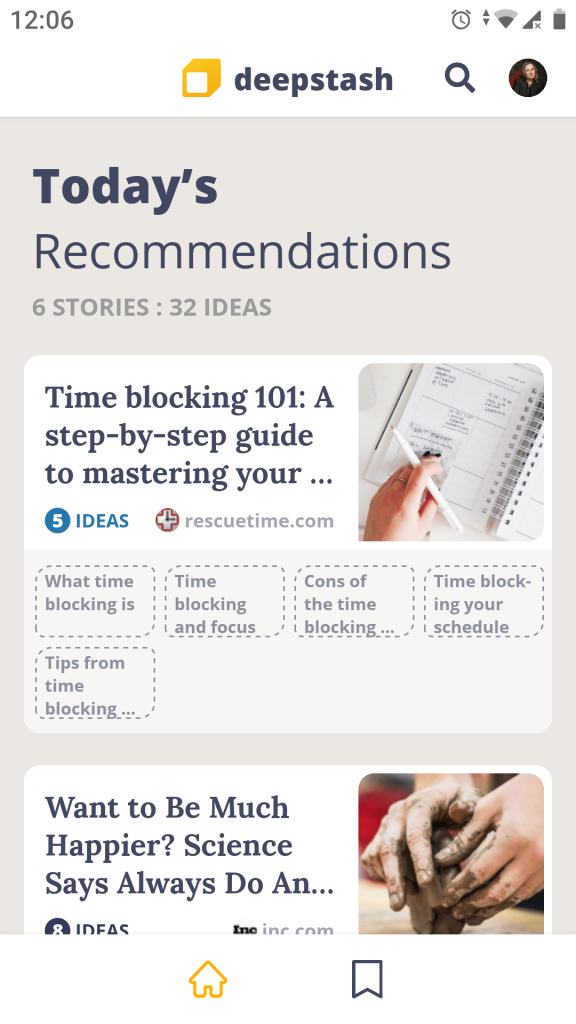
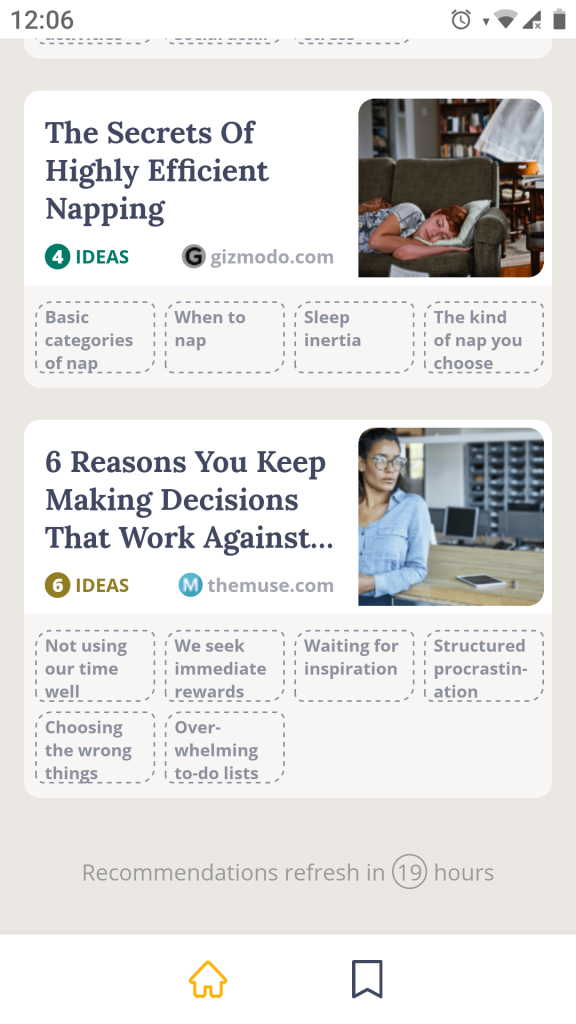

The app provides users with 8 various knowledge topics, each with eight to ten sub-topics:
- Self-improvement: Habits, Happiness, Inspiration, Motivation, Goal Setting etc;
- Time management: Productivity, Focus, Email Management, Appointments & Meeting, Scheduling etc;
- Communication: Listening, Writing, Negotiation, Nonverbal communication, Persuasion etc;
- Problem-solving: Creativity, Critical thinking, Design, Learning, Innovation etc;
- Team-work: Feedback, Collaboration, Office politics, Emotional intelligence, Empathy etc;
- Leadership: Conflict, Delegation, Dispute resolution, Interviewing, Management etc;
- Health: Diets, Nutrition, Bio-hacking, Mental Health, Meditation etc;
- Money & investments: Asset Classes, Saving, Investing, Stock Market etc.
Benefits of Deepstash:
- Provides its users with the main ideas, insights or takeaways from high-quality sources;
- Reinforces users’ motivation;
- Helps them start their day with a positive thought;
- Offers a new fresh perspective;
- Helps users avoid the marketing spread or buzzwords which some articles are full of;
- Users can save the ideas to reflect on later;
- Supports users achieve their goals or start a morning routine.
Do you use curation tools to increase your knowledge on specific topics?
Join the Conversation
We’d love to hear what you have to say.
Get in touch with us on Facebook Group and Twitter.
10 Growth Marketing Tactics To Grow Your Business
Are you looking to grow your business?
Read on to discover 10 growth marketing tactics!
10 Growth Marketing Tactics To Grow Your Business
Growth Marketing Tactic #1 – Sniply
Would you like to increase your conversion rates? Sniply is a great tool to achieve this goal.
Sniply is a simple tool that allows you to overlay your own custom message onto any piece of content, creating an opportunity for you to include a call-to-action with every link you share.
People use Sniply to drive conversions from every piece of content they share. You can drive traffic to your website, downloads of your app, registrations for your event, customers for your service, and more.
I created my first snip in 2 minutes and I chose to place it on one of Seth Godin’s blogs as you can see below:

Key takeaways:
- Make sure the page which hosts your snip and the page your snip sends visitors to match ie your content is relevant to the visitors of the host page;
- Create a clever CTA.
Growth Marketing Tactic #2 – LinkedIn Engagement Pods
Engagement pods started on Instagram and in recent years migrated to LinkedIn.
What are LinkedIn Engagement Pods?
LinkedIn Engagement Pods are private groups of Linkedin users who are all focused on engaging in and sharing other people’s LinkedIn content.
It’s a way to boost your post’s visibility on LinkedIn. This engagement gives your post a little nudge in the right direction but only if it’s high-quality content.
LinkedIn Engagement Pods can amplify your brand’s reach and provide you with opportunities for improved networking and/or collaboration.
If your company employs a large number of people, creating a Company LinkedIn Engagement Pod could empower your employee to become advocates on social.
Key takeaway:
- Choose your LinkedIn Engagement Pod carefully;
- Write content relevant to the pod’s members.

Growth Marketing Tactic #3 – Thank-you tags or coat-tailing
You post your piece of content and it starts receiving likes from the people in your network. What do you do when someone gives you something? You say ‘Thank you!’.
The same courtesy should apply online too. Growth Marketer Jeff Deutsch encourages marketers to say ‘Thank you’ in the comments of their posts and tag the people who liked them.
Why is it a growth tactic?
Because LinkedIn or Facebook or Twitter will show the posts where these people are tagged to other people in that person’s network which leads to increase visibility.

Growth Marketing Tactic #4 – Place the link to your article in the first comment
Every social network wants to keep you connected on its platform. That’s why all social platforms encourage and value engagement (likes, comments, shares) and frown upon posts with links that allow users to leave their digital space.
Posts with links receive less visibility than posts with no links. You have spent three to four hours carefully crafting your blog and you would like people to read it and rightfully so. But if you cannot place the link in your post what can you do?
You have two options:
- Publish the post with no link then edit it to include the link;
- Publish the post with no link but place the link in your first comment.
It’s been a week since I implemented this tactic and my posts with links in the first comment received increased visibility jumping from 50 views to over 400 views overall. That’s a 6x increase in visibility!
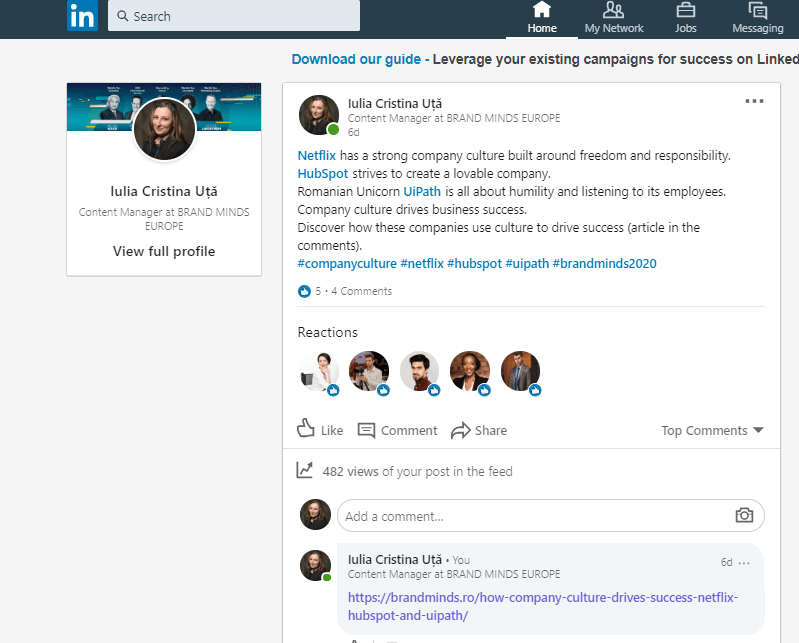
Growth Marketing Tactic #5 – Post native video on LinkedIn, Facebook, YouTube, Instagram and Twitter
Video is the best way to engage authentically with your customers. Although not everyone feels comfortable talking in front of the camera it’s a great way to get your customers to know you and build a connection.
All social media networks now allow users to post native videos. They encourage users to upload videos directly or go live on their platforms. As a result, video posts receive increased visibility.
Here are 10 smart ideas for video content you can use on LinkedIn and 10 Ideas to use Facebook Live in your Communication Strategy
Growth Marketing Tactic #6 – Pixel your visitor
Growth marketer Jeff Deutsch has this tip for marketers running Facebook ads: pixel your visitor, not your landing page.
Instead of placing your Facebook pixel on your landing page, place it on a blank HTML page. This page will pixel your visitors and redirect them to your landing page.
What does this tactic solve?
It tags people who leave before your landing page has loaded because they either lack patience or your landing page has a number of scripts that extend the loading time.
Jeff states this tactic is a way to stop losing 30% of your ad traffic.
![]()
Growth Marketing Tactic #7 – Facebook Messenger hack – the Auto-responder
Over 1 billion people use Messenger to connect with businesses every month.
MobileMonkey CEO Larry Kim found a way to take this opportunity to the next level: auto-responders.
In his article, Larry shows how to grow your Messenger subscription base with an auto-responder chatbot called Comment Guard.
Growth Marketing Tactic #8 – Gamification
Famous marketer Neil Patel lists gamification as a growth marketing tactic.
He recommends marketers to use gamification to their advantage by pulling their audience in with quizzes and polls to spark engagement and brand awareness.
To leverage gamification, marketers have to make content entertaining while also providing value.
According to Neil, gamified systems must tick three boxes:
- Give users motivation to do something (emotional investment, the promise of reward, etc.);
- The ability to complete the action;
- Provide a trigger or cue to complete the action.
Growth Marketing Tactic #9 – Piggyback on a thriving network
In 2016, Spotify integrated with Facebook Messenger allowing people to share their Spotify songs or playlists directly within a chatbox. This integration accelerated Spotify’s growth through referral traffic. Ultimately, millions of Facebook users also became advocates of the music platform because it filled the users’ desire to share their music socially.
Airbnb’s integration with the Craiglist platform is now the company’s most famous growth hack. In 2010, looking to access Craiglist’s huge user base, Airbnb built a bot to piggyback the platform. Check out the Airbnb growth case study.
What is the secret of successful integration with another platform?
Start with the perfect experience and work backwards.
Growth Marketing Tactic #10 – H.A.R.O
H.A.R.O. stands for Help A Reporter Out.
Help A Reporter Out is a media services company with over 35,000 journalists and 800,000 source members which started out as a Facebook group.
HARO allows sources to find topics related to their expertise, industry or experience while allowing journalists and bloggers to spend more time writing and less time sourcing. Subscribe as a source and you could be featured in mainstream media.
It’s a long-term effort but the potential benefits are worth it: increased brand awareness, augmented SEO, building business opportunities, establishing leadership credibility and garnering high levels of engagement on social.
What growth marketing tactics do you employ to grow your business?
Join the Conversation
We’d love to hear what you have to say.
Get in touch with us on Facebook Group and Twitter.
Artificial Intelligence (AI) in Healthcare is Expected to Grow to $36.1 billion by 2025
According to Markets and Markets, Artificial Intelligence (AI) in healthcare is expected to grow from $2.1 billion in 2018 to $36.1 billion by 2025, at a CAGR of 50.2% during the forecast period.
That’s the highest growth percentage among the growing industries we have previously analyzed on this blog: pet-food (4,8%), gaming, health & wellness (12.8%) and health & fitness (10%).

Source: marketsandmarkets.com
Topics:
- Reasons why Artificial Intelligence is disrupting the healthcare industry
- Artificial Intelligence in healthcare statistics
- Factors driving and limiting growth
- Artificial Intelligence applications in healthcare
- Examples of AI-powered apps
- Trends via CBInsights
- Big pharma partnerships with AI healthcare startups
Why is Artificial Intelligence disrupting the healthcare industry?
The reasons Artificial Intelligence is changing healthcare are quite obvious. AI is quicker and better than human doctors: the machine takes 15 seconds to read and diagnose scans while doctors arrive at a diagnosis in 30 minutes.
AI brings many benefits to the healthcare industry worldwide. Data-driven products and services result in cost cuts, treatment improvement, increased accessibility, higher-quality personalization and a more accurate initial diagnosis which leads to a more effective treatment plan.
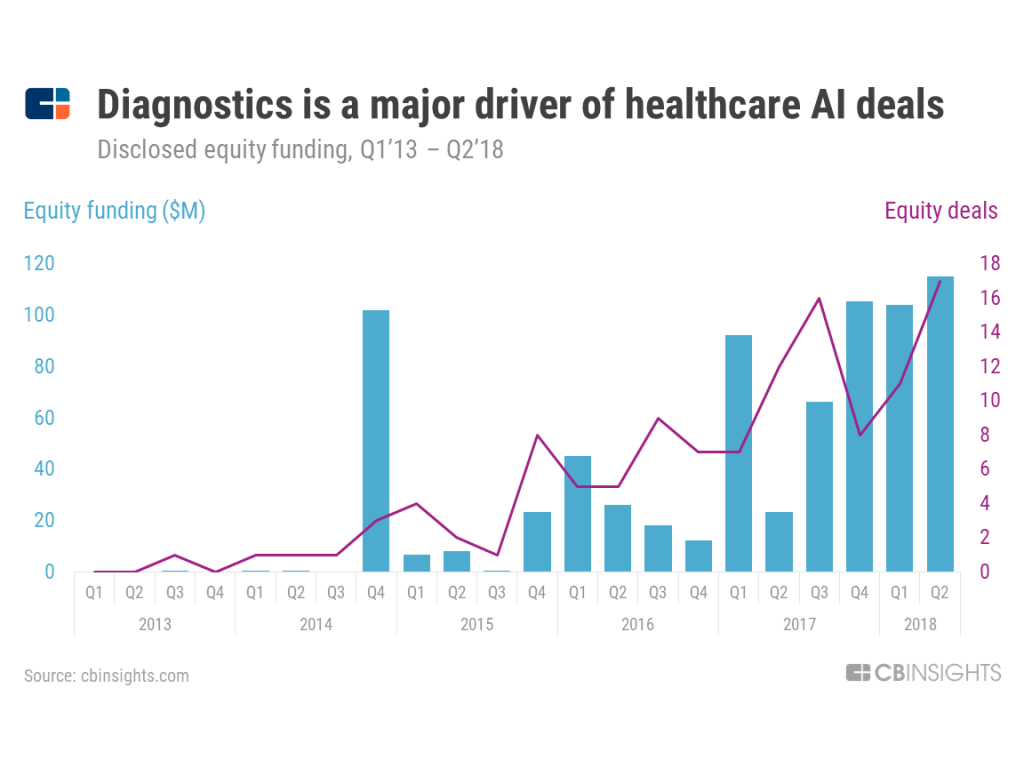
Artificial Intelligence in Healthcare Statistics
Between 2013 and 2017, more than 300 health care AI-related patents were issued with the following technology giants leading the charge: Alphabet filed 186 patents, Microsoft – 73 and Apple – 54.
Funding for U.S.-based AI and machine-learning health companies has increased more than 2,000% since 2011.
Factors driving the growth of Artificial Intelligence in healthcare
- increased number of artificial intelligence solutions;
- the ageing of baby boomers and prolonged life expectancies;
- advancements in clinical research;
- advancements in personal digital assistants;
- AI’s enhanced ability to reach an accurate diagnosis in the early stages of chronic diseases and disorders;
- increased funding in healthcare Artificial Intelligence;
- effective cost reduction in healthcare expenditures;
- the growing number of startups for AI in healthcare;
- the ability to share health information easily across institutions and software systems which is one of the most pressing issues in healthcare.
According to Healthcare Weekly, AI startups have raised $4.3B across 576 deals since 2013, topping all other industries in AI deal activity.
Factors limiting the growth of Artificial Intelligence in healthcare
- end-users’ reluctance to adopt Artificial Intelligence technologies;
- potential risks associated with Artificial Intelligence in healthcare;
- lack of trust.
Artificial Intelligence applications in healthcare
- appointment scheduling;
- insurance coverage checking;
- clinical imaging & diagnostics;
- developing new drugs;
- monitoring patients progress;
- precision surgery.
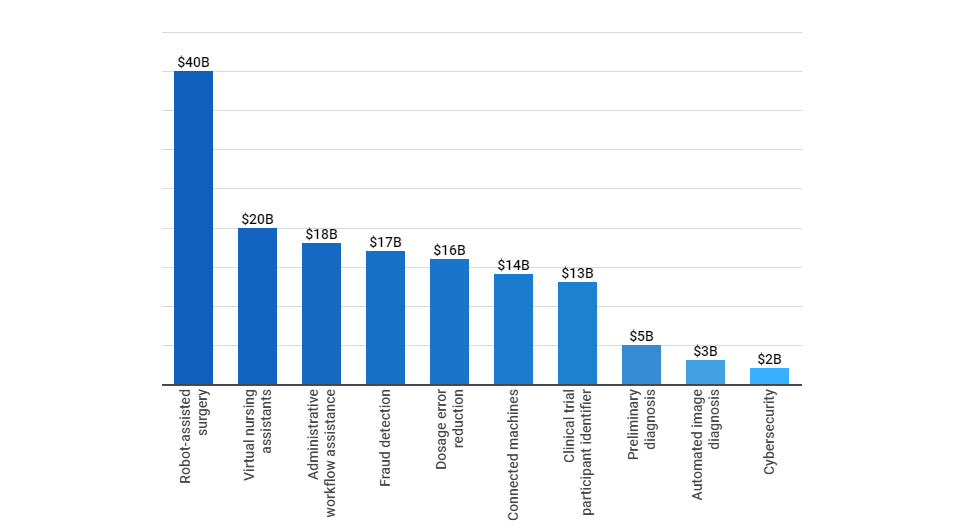
Source: forbes.com
AI-powered apps
Here, on the blog, we have talked about AI-based apps extensively.
Here are 3 healthcare apps developed on AI-based technology:
- the Child Growth Monitor built on Microsoft artificial intelligence solutions;
- Ginger.io, an app which offers professional coaching services to support employees’ emotional wellness;
- Replika, an app which helps users unlock their emotional intelligence.
7 Trends for AI in healthcare via CBInsights
1. AI-as-a-medical-device
Here are 3 AI software platforms which FDA has already approved:
IDx-DR is an AI software that screens patients for diabetic retinopathy without the need for a second opinion from an expert. The results are remarkable: it was able to correctly identify patients with “more than mild diabetic retinopathy” 87.4% of the time, and identify those who did not have it 89.5% of the time.
Viz.ai analyzes CT scans and notifies healthcare providers of potential strokes in patients. The company closed a $21 million Series A round from Google Ventures and Kleiner Perkins Caufield & Byers.
Arterys was FDA-approved last year for analyzing cardiac images with its cloud AI platform.
2. Using neural networks to identify the risk of heart disease
AI could potentially help identify the risk of heart disease. One algorithmic approach showed 85% accuracy in detecting diabetes from heart rate.
3. Building a clinical research ecosystem
With iPhone and Apple Watch, Apple is the first tech company to build a health records ecosystem. Since 2015, Apple has launched two open-source frameworks — ResearchKit and CareKit — to help clinical trials recruit patients and monitor their health remotely.
In January 2018, Apple announced that iPhone users will now have access to all their electronic health records from participating institutions on their iPhone’s Health app.
4. Traditional pharma companies looking to AI SaaS startups for innovative solutions
Big pharma companies have recognized the huge potential and the benefits AI can offer to healthcare.
Pfizer entered into a strategic partnership with XtalPi — an AI startup backed by tech giants like Tencent and Google — to predict pharmaceutical properties of small molecules and develop “computation-based rational drug design.”
5. Chinese investments in AI healthcare are on the rise
The Chinese government issued an artificial intelligence plan last year, with a vision of becoming a global leader in AI research by 2030. Healthcare is one of the 4 areas of focus for the nation’s first wave of AI applications.
Chinese big tech companies are now entering into healthcare AI with strong backing from the government. WeChat, Facebook’s competitor in Asia has reached 1 billion users. Also called the “app for everything”, WeChat reported 38,000 medical institutions had accounts last year, of which 60% allowed users to register for appointments online. Also, more than 2,000 hospitals accept WeChat payment.
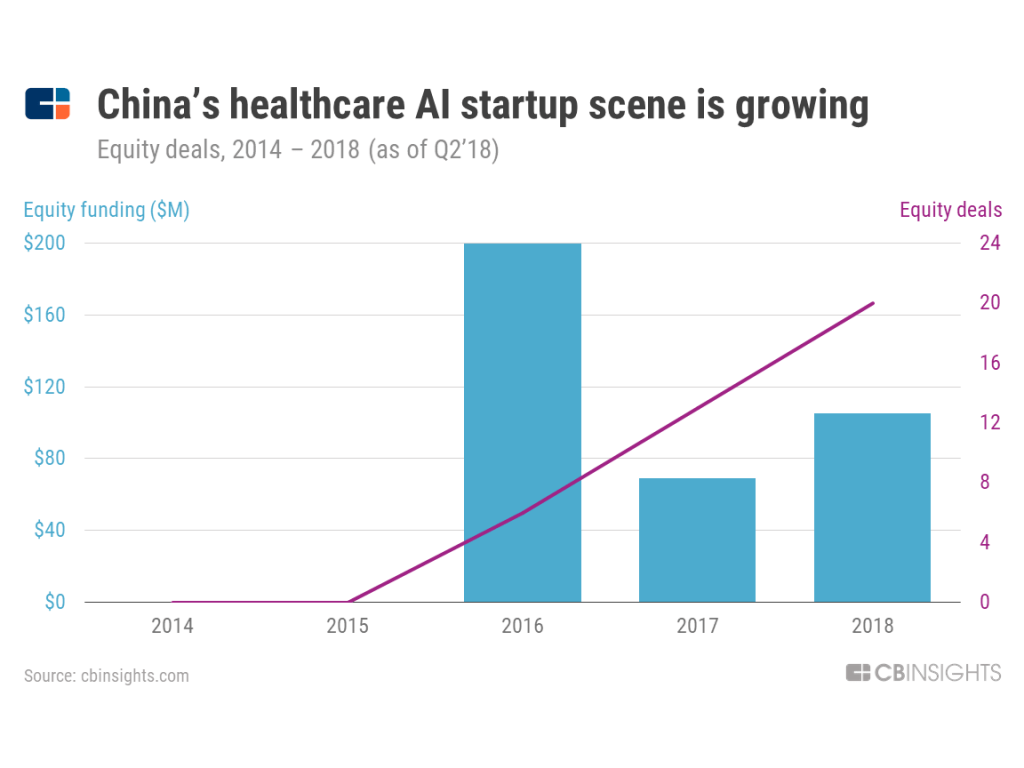
6. DIY diagnostics
AI has turned smartphones and consumer wearables into powerful at-home diagnostic tools. Dip.io performs urine analysis via a smartphone camera and SkinVision monitors skin lesions and assess skin cancer risk.
7. Therapy bots
From life coaching to cognitive behavioural therapy to faith-based healing, therapy bots support users’ mental health and help them change negative thoughts and behaviours through conversations. Check them out: Woebot, Wyse, Tess, Sister Hope, WisdomBot etc.
Big pharma partnerships with AI healthcare startups
1.Pfizer partnered with XtalPi, a U.S.-China biotech firm that uses artificial intelligence and computing to accelerate the development of new drugs. XtalPi has raised a total of $67.6M in funding.
2. Merck partnered with Atomwise which develops artificial intelligence systems for drug discovery. Atomwise has raised a total of $51.3M in funding.
3. GlaxoSmithKline partnered with Insilico Medicine which develops high-performance AI platform for drug development to treat cancer and age-related diseases. Insilico Medicine has raised a total of $14.3M in funding.
4. Mayo Clinic partnered with Beyond Verbal which uses voice and AI to revolutionize healthcare, well-being and emotional Understanding. Beyond Verbal has raised a total of $10.1M in funding.
5. Novartis partnered with Pear Therapeutics to create software applications to treat patients with schizophrenia and multiple sclerosis. Pear Therapeutics has raised a total of $134M in funding.
6. Sanofi partnered with Recursion Pharmaceuticals which combines experimental biology, automation, and artificial intelligence to discover treatments. Recursion Pharmaceuticals has raised a total of $226.4M in funding.
7. Janssen Pharmaceutical partnered with BenevolentAI, an advanced technology company focused on accelerating the journey from data to medicines. BenevolentAI has raised a total of $202M in funding.
8. Roche Holding acquired Flatiron Health for $1.9B in February 2018. Flatiron uses machine learning to mine patient data.
Sources: healthcareweekly.com, cbinsights.com, forbes.com, fastcompany.com, crunchbase.com
Join the Conversation
We’d love to hear what you have to say.
Get in touch with us on Facebook Group and Twitter.
How To Optimize Your Content for Google’s Featured Snippets
Every marketer wants to optimize their content so it shows up in Google’s featured snippets.
Why?
Because featured snippets display content differently than the blue links with short descriptions that we are all so familiar with.
Also because featured snippets rank in position zero, above the first organic search results.
What are featured snippets (also known as position zero in search results)?
Featured snippets (or rich results) are a special feature of Google Search which provides the content with unique formatting and positioning. Also, featured snippets are often spoken aloud by the Google Assistant.
Google’s featured snippets help marketers get their content indexed appropriately and therefore allowing it to stand out from the rest of the content available on the web.
Of course, Google doesn’t guarantee that your piece of content – may it be a blog post, a YouTube video, a product review etc – will show up in featured snippets, even if your page is marked up correctly, but it certainly increases the likelihood.
Ahrefs studied 2 million featured snippets and discovered they get more traffic than the first organic search result.
How can you increase your content’s likelihood of showing up in Google featured snippets?
Use structured data on your website pages.
Google uses structured data to understand the content of the page, as well as to gather information about the web and the world in general.
Structured data is a standardized format for providing information about a page and classifying the page content. For example, on a recipe page, including structured data shows Google what are the ingredients, the cooking time and temperature, the calories, and so on.
Structured data provides Google with explicit clues about the meaning of a page. Learn more about structured data.
5 content formats you should optimize to show up in Google’s featured snippets
1. FAQ
On May this year, Google announced support for FAQ pages structured data on Google Search and the Google Assistant.
To improve customer experience, it is useful to write an FAQ page and host it on your website. An FAQ page is a page where your company provides your customers with relevant answers to their questions on a particular topic.
By marking your FAQ page with structured data you can make your content eligible for direct display on Google Search and the Assistant. Learn how to implement structured data on your FAQ pages.
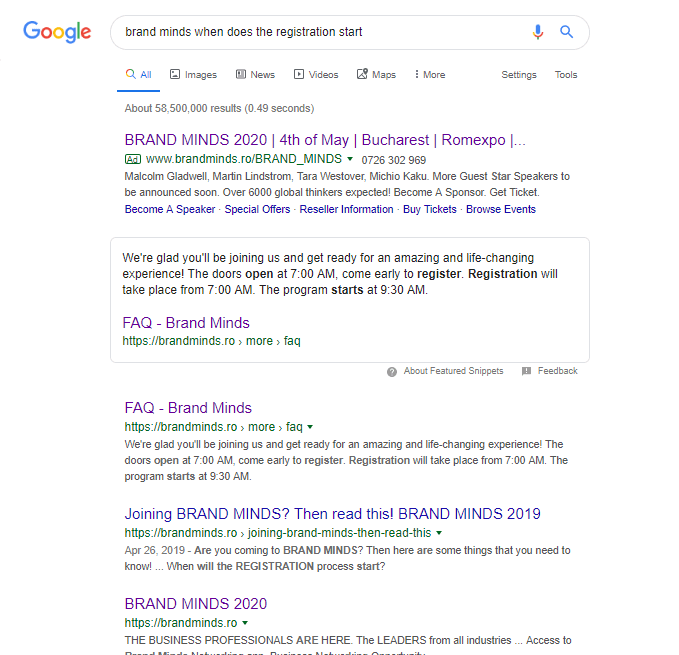
2. How-to
The How-to article is one of the most popular types of content on Google.
Writing How-to articles helps your customers achieve a specific goal or task by delivering information step-by-step.
A How-to query on Google indicates the user is looking to learn something new, to solve a problem or to improve a situation: how to make lasagna, how to bring down a fever, how to care for an orchid, how to fight loneliness etc.
Add How-to structured data to your pages to enable the page to appear as a rich result on Search and a How-to Action for the Assistant.
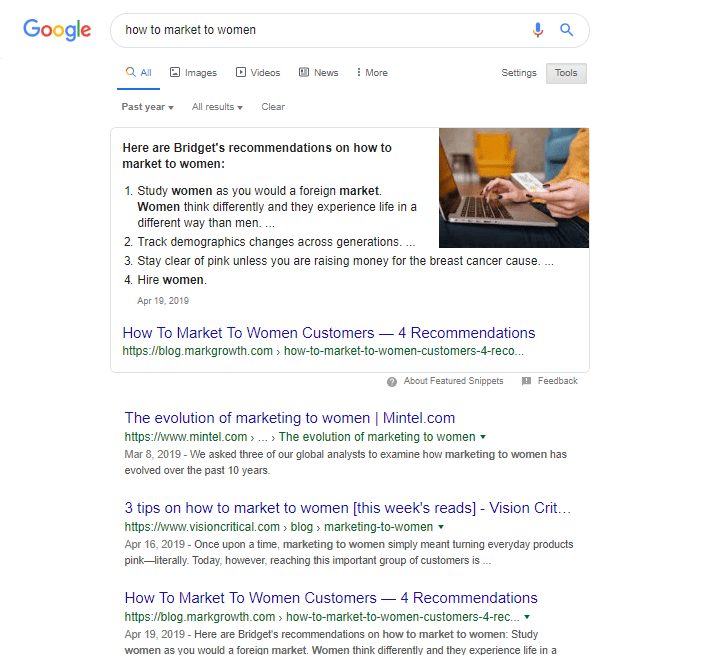
3. Lists / Tops
Writing content in the form of lists or tops is beneficial both to your website and your customers.
This type of content provides customers with bulleted or numbered choices: Top 10 universities in the UK, Top 3 marketing agencies in India, Best 5 social media listening tools etc.
Google shows your list in featured snippets helping its users to see the answer they’re looking for at a glance.
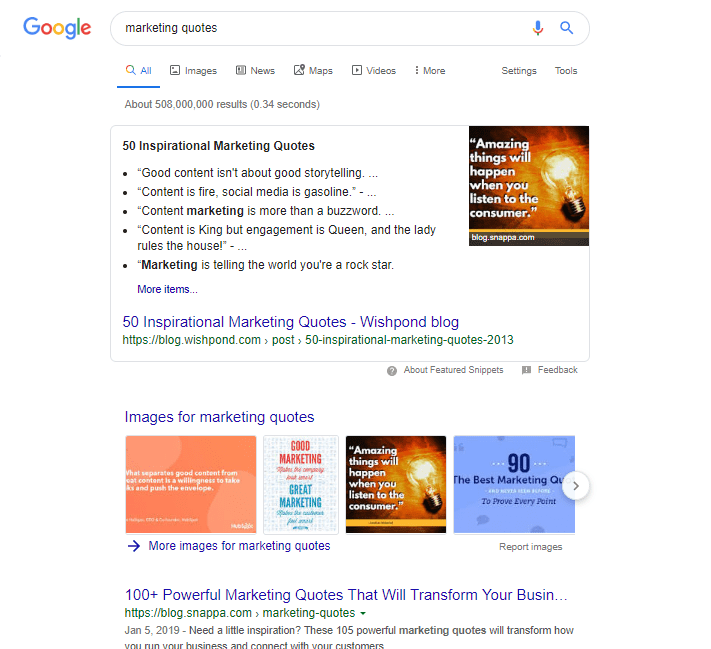
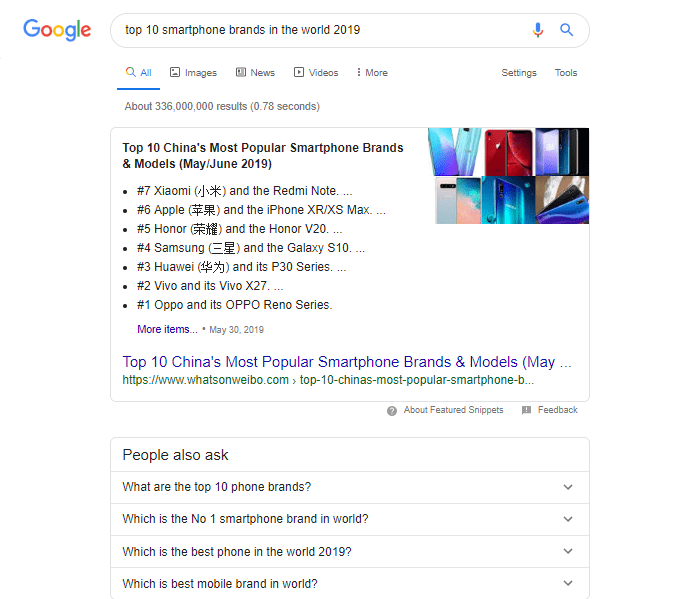
4. Featured clips
Featured clips are videos pulled from YouTube that appear in a featured snippet position. Don’t confuse them with the video carousel.
The clips showing up in featured snippets auto-start and stop at the exact section of the video that answers the searcher’s query.
HubSpot conducted research on what makes videos show up in featured snippets. Here are the report’s main takeaways:
- Include the exact keyword in the video’s name;
- Video length doesn’t matter;
- Update your older video content;
- Write a short transcript and put it in your video’s description.

5. Definitions
Definitions show up in featured snippets when they provide the answer to a question.
It isn’t mandatory for the search query to include the question What is…? as you can see below.


Is your content optimized for Google’s featured snippets?
Join the Conversation
We’d love to hear what you have to say.
Get in touch with us on Facebook Group and Twitter.
How Company Culture Drives Success – Netflix, HubSpot and UiPath
What is company culture? Company culture is a set of shared beliefs, values and practices.
Let’s see how Netflix, HubSpot and UiPath define their company culture and why it is central to their success.
Netflix Company Culture – With Empowerment comes Trust and Expectations follow. The ‘No Rules Policy’.
Netflix is one of the first companies to draft an in-depth long-form employee culture manifesto.
It’s been ten years since Netflix CEO Reed Hastings published his SlideShare presentation detailing his company’s employee culture. The slide has gained over 19 million views to date.
It certainly caused quite a stir among people worldwide! And let me say it again: it was 2009 when the world was still suffering the consequences of the global financial crisis (rising unemployment, declining economic growth, etc).
What makes Netflix’s company culture special?
Instead of tightening its control on employees which is what any other company would do in times of turmoil, Netflix was taking a different and surprising approach.
Like all great companies, Netflix strives to hire the best. So do a thousand other companies, nothing special about that.
Building a great employee culture doesn’t stop with hiring the best people for the job, that is only the beginning.
The hardest part comes after the hiring process has ended and it involves getting every employee on the same page.
How does Netflix do that?
By empowering its employees, trusting them to make the right decisions and expecting them to deliver high-quality work.
Oh, and one more thing: avoiding rules. Now that’s pretty unusual.
We don’t have rules about picking up the real or metaphoric trash. We try to create the sense of ownership so that this behaviour comes naturally.
Our goal is to inspire people more than manage them. We trust our teams to do what they think is best for Netflix — giving them lots of freedom, power, and information in support of their decisions. In turn, this generates a sense of responsibility and self-discipline that drives us to do great work that benefits the company.
We believe that people thrive on being trusted, on freedom, and on being able to make a difference. So we foster freedom and empowerment wherever we can.
We work to have a company of self-disciplined people who discover and fix issues without being told to do so.
“Use good judgment” is our core precept.
Netflix
9 ways Netflix nurtures employee freedom and encourages responsibility:
- Management shares documents internally broadly and systematically;
- No spending controls or contract signing controls;
- Travel, entertainment, gifts, and other expenses are allowed if employees “Act in Netflix’s best interest”;
- No compliance departments that most companies have to enforce their policies;
- Unlimited vacation policy which encourages employees to intermix work and personal time at their own will. It helps them get back to work with fresh new ideas;
- Netflix’s parental leave policy is: “Take care of your baby and yourself”;
- No compensation handcuffs – “People are free to leave at any time, without loss of money, and yet they overwhelmingly choose to stay. We want managers to create conditions where people love being here, for the great work and great pay”;
- The company is strict about ethical issues and safety issues, it shows zero tolerance for harassment or trading on insider information;
- Holding meetings is another corporate pain point that Netflix deals with differently than other companies. The company schedules effective meetings where the meeting starts and ends on time with well-prepared agendas. The main takeaway from this is these meetings are more about learning from each other and get more done than preventing errors or approving decisions.
Every company or/and employee culture is a reflection of the executives working there.
Netflix
HubSpot Company Culture – We dare to be different
HubSpot is a platform uniting software, education, and community to help businesses grow better every day.
The company was co-founded by fellow MIT graduates Brian Halligan and Dharmesh Shah in 2005.
This year, HubSpot was named a Best Workplace for Millennials by Great Place To Work and Fortune, #2 Best Company for Professional Development, Leadership and a Best CEO for Diversity and Women by Comparably. 2700+ HubSpot employees work in 8 global offices.
So how does HubSpot define its company culture?
In 2013, HubSpot published the Culture Code: Creating a Lovable Company on SlideShare.
They state company culture is an obsession because culture doesn’t just help attract amazing people, it amplifies their abilities and helps them do their best work.
What makes HubSpot’s company culture special?
HubSpot set themselves apart from other companies by being different.
How are they different?
They are maniacally committed to their mission and their metrics.
Their mission is to help organizations grow and metrics help them earn the resources to further their mission.
9 ways HubSpot ensures they are different and how employees benefit from it:
- They share openly and are remarkably transparent (financials, board meeting deck, management meeting deck, strategic topics, etc);
- ‘No door’ policy – “Everyone has open access to anyone in the company.”
- They favour autonomy and take ownership;
- When employees need to make a decision the only rule is to use good judgement;
- Employees need to follow only two rules: Don’t solve for your personal interests to the detriment of the team. When in doubt, favour solving for the customers’ interests over our own;
- Long-term interest prevails over anything else;
- “Don’t just hire to delegate. Hire to elevate“;
- “Remarkable outcomes are rarely the product of modest risk.”
- They refactor to continue on being exceptional. They look for simplicity so they avoid turning into a Goliath of an organization – slow to adapt, less innovative, easily outrun by the competition.
Power is gained by sharing knowledge, not hoarding it.
HubSpot
UiPath Company Culture – Humility drives innovation
Co-founded in 2005 in a tiny apartment in Bucharest by Daniel Dines and Marius Tirca, the Romanian RPA has certainly come a long way from its humble beginnings.
Today the company has additional offices in London, Paris, Tokyo, Singapore, Bengaluru and Melbourne.
In 2018, among tens of thousands of large U.S. companies, UiPath has been awarded the 11th Best Place to Work, based on company culture, and one of the top 50 Best Companies for Women and Diversity. Also, UiPath ranked sixth for Happiest Companies in Comparably’s 2018 Culture Awards.
In 2019, UiPath was named a Gartner Magic Quadrant Leader for Robotic Process Automation Software. This recognition celebrates the company’s ability to execute and completeness of vision.
Starting with July 2020, UiPath has become the first European Cloud Decacorn with $10.2Bn valuation in a new funding round of $225M.
What makes UiPath’s company culture special?
UiPath’s purpose is to accelerate human achievement.
They set out to change the way work is done, but they are keen on making their people happy. If their people are not happy, they have failed no matter how successful they are.
UiPath believes that a happy employee is an employee who is listened to by their leaders. And being successful as a leader means exercising humility and practising active listening.
They also state that the company’s future is centred on psychological safety beyond anything else. With global expansion and technological connectedness come unique challenges.
It’s paramount the company finds ways to overcome these challenges and stay on the path to innovation.
The core values of UiPath are speed, immersion, boldness and humility.
7 ways UiPath provides its employees with a psychologically safe workplace:
- Authenticity – The company doesn’t expect its employees to fit a certain mould. Instead, they are encouraged to be who they really are. “We hired you for your unique experience and insight.”
- Trust and ownership from day one – Employees support each other whether they know each other or not;
- Everyone is empowered to speak up if they have an idea even if it’s outside of their expertise because it shows they care and maybe it’s a different perspective the company should take into consideration;
- Humility – Employees are expected to be humble, open and listen in order to learn even that at which they already excel; they are encouraged to get their hands dirty and do whatever it takes to drive towards innovation;
- The company encourages its employees to acknowledge and address their fears because this is the key to personal growth and team improvement;
- UiPath leaders are trained to listen, really listen to their team members and be ready to give and take criticism;
- Employees are encouraged to disconnect their mind from work when they’re at home. This allows space for inspiration and ideas flowing freely which is a great way to keep moving towards excellence.
Buckle up – you’re about to board a rocket ship into uncharted space. This company is a meritocracy and your potential is limitless.
UiPath
Conclusion
All three companies run highly successful businesses with thousands of employees working in offices spread across the world.
The elements that all of them have in common are trust, responsibility and empowerment. Netflix expects its employees to act in the company’s best interest, HubSpot encourages them to use good judgement and UiPath ensures a safe work environment to drive innovation.
What is your company culture?
How does your company culture support your organization achieve its business objectives?
Join the Conversation
We’d love to hear what you have to say.
Get in touch with us on Facebook and Twitter.
Meet Daisie, the app developed by Game of Thrones star Maisie Williams
Maisie Williams who starred in the widely acclaimed TV series Game of Thrones developed an app called Daisie.
Game of Thrones star Maisie Williams signed on to act in the now-famous fantasy series when she was twelve.
Ten years later, young creatives were asking her what they could do to be successful in the industry of their choice: arts, film etc. She didn’t know what to tell them – it’s not like the combination of opportunity and talent that put her on the right path could be replicated.
Or could it?
Her idea for Daisie crystallized while talking to film producer Dom Santry on the set of one of her latest movies. He was telling her “how difficult it was for young creatives to access opportunities that can progress their careers.”
Daisie – Bringing creators together to do amazing work
Daisie is a social app based on creative collaboration.
It’s a hub where creatives of all ages come together and collaborate on projects: musicians, artists, designers, illustrators, film photographers, poets and content creators.
Unlike Instagram or Twitter, Daisie has no follower count which eliminates the popularity contest from the get-go and allows someone’s profile to grow and gain traction.
“We see Daisie as a place where you turn ideas into projects and we help you find the team you need to create something special,” Maisie explains. “Opposed to other platforms, it’s a place to find your audience. For that reason, we don’t see Daisie becoming a rival.”
Mission
Daisie is founded on the belief that pushing forward together, with a shared vision, is what sparks creativity and drives change. It’s our purpose to bring creators together and support them to do amazing work.
Our mission is to see Daisie creators grow in confidence, take up space in their chosen fields, and build lasting careers. It’s our hope that ‘Made with Daisie’ becomes synonymous with groundbreaking and impactful creativity at all levels, in all fields, and from creators of all kinds.
Daisie is where people find their people, get inspired, and make real progress together. It’s a new route into the creative world; through connections made organically and the natural development of skills.
Here’s what you need to know about Daisie app:
- Co-founded in 2017 by actress Maisie Williams and film producer Dom Santry;
- The app was launched into an invite-only beta on iOS in the summer of 2018;
- It crashed after it received 37,000 downloads in week one;
- The app was officially launched to the public on May 8, 2019;
- 11 days after the launch, the app hit an early milestone of 100,000 members;
- It recently closed on $2.5 million in seed funding;
- The team grew from 5 to 18 members coming from established companies like Monzo, Deliveroo, BBC, Microsoft;
- The co-founders plan to take Daisie to other cities including Berlin, New York, and L.A.;
- The app does not currently generate revenue, but the team are looking into ways to monetize it;
- It is already receiving inquiries from companies who want Daisie to find them the right talent for their projects.
Join the Conversation
We’d love to hear what you have to say.
Get in touch with us on Facebook and Twitter.
What is Krulak’s Law of Leadership?
Unless warfighting philosophy is one of your interests, the name Krulak is unfamiliar to you.
But don’t feel bad about it! We’re all here to learn.
Who is Krulak? What is Krulak’s Law of Leadership?
Read on to find out.
General C. Krulak – “Warrior Prince of the Corps”
Charles C. Krulak is a retired General in the United States Marine Corps.
During his extended marine career, he held a variety of command and staff positions: commanding officer during two tours of duty in the Vietnam War, commanding general during the Gulf War, the commander of Marine Forces Pacific, nominated to serve as the Commandant of the Marine Corps then finally promoted to general. In September 1987 he was assigned duty as the Deputy Director of the White House Military Office.

General Charles C. Krulak / wikipedia.org
For his military merits and exemplary leadership, General Krulak was awarded many decorations and medals among which Navy Commendation Medal, Combat Action Ribbon, Army Distinguished Service Medal, Purple Heart with gold star, French Legion of Honor, Commander and Silver Star.
American novelist Tom Clancy, author of famous novels translated into Hollywood movies The Hunt for Red October, Patriot Games and the Jack Ryan series, referred to Krulak as “Warrior Prince of the Corps” and explained some of his warfighting philosophy in his nonfiction book ‘Marine’.
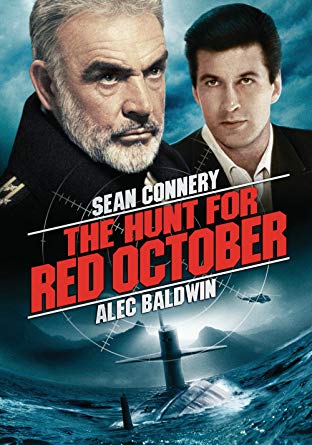
image source: amazon.com
General Krulak was Birmingham-Southern’s 13th president. In honour of him, the college established in 2015 the Krulak Institute for Leadership, Experiential Learning, and Civic Engagement. The institute serves as the focal point for experiential learning opportunities and leadership development programming.
Seth Godin talks about Krulak’s Law of Leadership in two of his blog articles: The $50,000 an hour gate agent and The closer you get to the front, the more power you have over the brand.

What is Krulak’s Law for Leadership?
In 1999, General Krulak published an article in Marine Magazine entitled The Strategic Corporal: Leadership in the Three-Block War in which he shares the key lessons identified from the deployments in Somalia, Haiti and Bosnia. You can read the article here.
The Three-Block War is a concept devised by Krulak to illustrate the complex spectrum of challenges likely to be faced by Marines on the modern battlefield.
Within the space of just three adjacent city blocks, Marines may be required to conduct full-scale military action, peacekeeping operations and humanitarian aid. Krulak’s conclusion is that modern militaries must be trained to operate in all three conditions simultaneously, and that to do so, leadership training at the lowest levels needs to be high.
To conduct their missions to positive results, the need arises for a new kind of military – the strategic corporal. Krulak defines strategic corporal as low-level unit leaders able to take independent action and make major decisions.
Krulak’s Law of Leadership states that the future of an organization is in the hands of the privates in the field, not the generals back home.
In our quickly developing world supported or disrupted by technology, leaders need to nurture the strategic corporals of their companies.
Today there is no time for taking decisions at the top and passing them down to low-level ranks. The employees must make split-second decisions which could have a serious impact on the company’s reputation and brand awareness.
A leader’s main responsibility is to ensure that their employees make the right decisions.
How can the leader in question support his/her employees to this end?
General Krulak gives the following answer:
- Offer them the freedom to fail and with it, the opportunity to succeed;
- Micro-management must become a thing of the past;
- Supervision must be complemented by proactive mentoring;
- Empower them, hold them strictly accountable for their actions;
- Allow the leadership potential within each of them to flourish.
Leaders are judged, ultimately, by the quality of the leadership reflected in their subordinates.
General Krulak
Do companies implement Krulak’s Law?
The Circle of Safety
When employees are allowed to fail they also feel encouraged and supported to succeed.
Trust is a vital factor in the relationship between the leader and their employee. Also, trust goes both ways.
When the leader establishes the circle of safety in their company, the employees are inspired to deliver their best work and support the organisation to become successful.
Learn more: Simon Sinek – The Circle of Safety
When people feel appreciated by the organisation, they feel safe and relaxed.
This allows them to care about and connect with their colleagues and start working as a team to support the organisation achieve success and prosperity. There are no threats coming from inside the organisation so people are more prepared to protect the company from outside threats.

image source: linkedin.com
Nokia’s demise
It’s not how Nokia employees felt.
Nokia’s fall can be put down to internal politics. The giant company did not implement Krulak’s Law.
In short, Nokia people weakened Nokia people and thus made the company increasingly vulnerable to competitive forces.
Experts found that fear had permeated all levels. Employees in the lower levels of the organisation turned inward to protect resources, themselves and their units. They didn’t join forces to protect the organization because they were protecting their personal careers. They didn’t share with their higher management what was really going on and so the giant communication company failed to adapt and innovate.
Learn more: Why did Nokia fail?

source: medium.com
Netflix’s success is driven by its employee culture
Netflix implements Krulak’s Law of Leadership brilliantly. The company’s employee culture is one of a kind and a standard in modern leadership.
Underpinning Netflix’s employee culture are two factors: freedom and responsibility. The company empowers its employees, trusts them to make the right decisions, and expects them to deliver high-quality work.
Our goal is to inspire people more than manage them. We trust our teams to do what they think is best for Netflix — giving them lots of freedom, power, and information in support of their decisions. In turn, this generates a sense of responsibility and self-discipline that drives us to do great work that benefits the company.
We believe that people thrive on being trusted, on freedom, and on being able to make a difference. So we foster freedom and empowerment wherever we can.
We work to have a company of self-disciplined people who discover and fix issues without being told to do so.
“Use good judgment” is our core precept.Netflix
Join the Conversation
We’d love to hear what you have to say.
Get in touch with us on Facebook and Twitter
5 Tips For Better Internet Security to Secure Your Business’s Future
As an entrepreneur, your efforts are focused on securing the future of your business in the form of funding, marketing and sales, brand awareness.
What you might not be aware of is that internet security is equally important.
Read on to learn how to secure your business’s future through better internet security.
Last year saw the introduction of the GDPR legislation.
This year, we’ve started seeing companies facing stiff fines thanks to contravening these regulations. The fines imposed can be substantial. You’re looking at between 2% and 4% of your annual turnover. And, if you’re thinking, “How bad could it really be?” the maximum fine is €20 million.
Complying with GDPR must be part and parcel of your business plan going forward. It makes sense to consider having an expert in security awareness training come in and update your staff on how to improve their data security as soon as possible.
Learn more: What is CEO Fraud?
![]()
Here are 5 tips to get you started on the right foot:
1. Creating stronger passwords
Having a strong password is not going to guarantee that you won’t get hacked, but it helps stack the odds in your favour. Start by selecting a new password with at least 16 characters and randomized characters.
2. Use a unique password for business purposes
Everyone at your business must choose a unique password that is only used for logging into your system.
3. Conduct a phishing test
This is where you send out an email like one that a phisher would use. You’ll need to monitor which staff members click on the link in the email. If someone falls for it, they’ll need more training in recognizing phishing emails.
4. Reconsider allowing staff to use their own devices
It’s convenient for your staff to be able to use their own devices. The problem is that their devices might not be as secure as you like. It’s a better idea to get your staff to use a company device or to ensure that their devices are as secure as your office systems.
5. Consider enabling two-factor authentication
It’s not a bad idea to make use of two-factor authentication when logging into the office systems. It’s only going to add a minute or two to the sign-in process, but it’s a great way to make your system more secure.
If you’re looking for even more tips, check out the infographic we’ve got for you below.
Better security is only going to be better for your business.
Take some extra steps today to secure your company’s tomorrow.

Image source: EveryCloud
Join the Conversation
We’d love to hear what you have to say.




